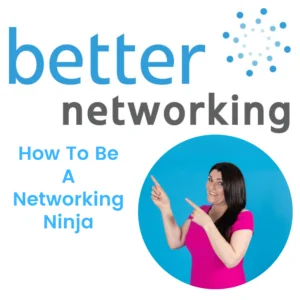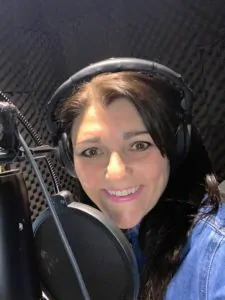This podcast is all about the unspoken communications of body language. Here is the transcript/blog containing the details of this Be Better With Tracy Heatley podcast.
Introduction
Management consultant and author, Peter Drucker said, “The most important thing in communication is hearing what isn’t said.
This is so true when it comes to networking. You may not get a second chance to make a first impression, so let’s make that first impression count.
Networking Fears
Here is how to take your networking FEARS away through body language. These will help you communicate the right message and convey a ‘let us do business’ attitude.
Using the FEARS acronym, let us now focus on face, eyes, arms, rapport and stance.
Face
Your face is usually the first thing that people see, and many people, particularly those who are very perceptive will notice subtle expressions and characteristics. Some people find it easy to hide emotions, whilst other people naturally seem to wear their heart on their sleeve. Either way, when you’re networking, it’s important that you leave any challenges or misgivings at the door. Metaphorically speaking of course!
A smile goes a long way to reaching out to people. After all, we all smile in the same language. Avoid frowning where possible. I know for some people this is not always easy. Particularly if you frown while you’re concentrating, perhaps one what someone is saying to you, for example. However, do be aware of this.
Also think about being tension free when you enter a networking event or meeting. Often tension shows in your face and radiates throughout your body. Whether you mean to or not, you could make other people feel tense. Being mindful of this is the first step. Speaking of being mindful, learn some positive anchoring or calming techniques that you can use before you enter the meeting.
Eyes
I’ve heard it said that the eyes are the mirror of the soul. I guess what that means is that sometimes, particularly if you’ve got strong emotional intelligence skills, it’s easy to read someone by their eyes. If you’re a very visual person, you will naturally find it easy to make eye contact with people. However, not everyone does. If you are someone who either hasn’t thought about the relevance of eye contact or you struggle with it, please don’t’ worry about it.
We’re All Different
We’re all different, and with practise, even if it doesn’t come naturally, it is a communications skill that you can learn and improve upon. When I’m working with my networking and communications training clients, we spend a lot of time establishing communications styles, the impact of them and how you can adapt to build a better rapport. So, if you are thinking about doing my one of my training courses, you’ll learn advanced skills in this area. However, even if you’re not training with me, you can still practise making eye contact.
Be Focused
Learn to be focused on the person you’re talking to and remember that for some people, it’s important you look at them in order for them to believe that you’re listening too to too them. If you do find it difficult to maintain eye contact, at the very least do keep glancing at the person or group of people that you’re communicating with.
If you’re networking online do keep focused, if you’re looking down on your phone, looking away at another screen or simply listening in, whilst doing other work, your eyes will give it away. Even on Team or Zoom, your eyes will show if you’re there in the moment or you’re distracted, so let your eyes portray the message you want them to.
Arms
Have you ever looked at someone and made an assumption about what kind of a mood they’re in or if they’re open to talking to you? I know I have. And I know I’m not alone. Whether we like it or not, our mood shines through our body language, so if you’ve had a bad day so far or you’re not in a great mood, right now, you can change that, just by changing your physiology.
Your Arms Tell A Story
This is why your arms are crucial to networking and communications success. Your arms tell a story. They let the other person or people you’re networking with know if you’re approachable or not. Whether you’re open to discussion or not. If you’re friendly or not. Regardless if you actually want to be there or not. Don’t get me wrong, I’m not suggesting that you may be closed, unfriendly or ignorant. However, it’s how you’re perceived by others that counts, not necessarily how you perceive yourself that counts.
Imagine for a second that you saw someone who you wanted to speak to, and they had their arms folded, what would your perception be? Now imagine a situation where the person you want to speak to is literally welcoming you with open arms. As you notice the difference in your perception now, and observe this different perception, do spot the impact that this can have.
I’m not suggesting that you welcome everyone with open arms, but what I am suggesting that as you become more and more mindful of your arms and the message you’re sending out to others, adjust your arms to suite the situation. Even by having your arms by your side, with palms open, you’re portraying a greater sense of openness and friendless ness than you know right now.
Using Your Arms And Hands
I can’t quite remember which business article I was reading when I saw this, but there was a ‘Ted Talks’ article about some research that had been completed to do with professional speakers, and the ones who used their arms more whilst delivered a speech were more successful. Therefore, I think it’s reasonable to suggest that using your arms and hands when networking is vital. Whilst there isn’t enough time to go into great details during this particular podcast, I would like to give you a few tips and observations that may help you.
Firstly, if you do happen to be talking about yourself moving your hand and placing it on the centre of your chest often evokes authenticity.
Whilst you may naturally default to having your arms folded, try and refrain from doing this. It’s one of the most closed forms of communication. That said, I do understand that for some people, it feels comfortable to do this. If you’re one of them, try to lower your arms, join your hands and cross your hands instead. Keeping your hand unlinked and open would be ideal, joining your hands in this way, may still make you feel more comfortable and will be received more favourably by the person you’re communicating with. If you’re communicating online simply lower your folded arms, so that they’re resting on the desk or they’re out of sight from your camera. That way, you feel comfortable and the person you’re communicating with can’t tell you’ve got your arms folded.
Mirror The Other Person
My fist a final tip is to use your arms and hands to keep the focus on you, rather than looking elsewhere around the room. You can do this by having such an excellent rapport that you and the person or people you’re communicating with that neither party wonders, wither physically or mentally. You can use your arms and hands to mirror the person you’re communicating with, so that you’re in a similar position. Yes, even if they’ve got their arms folded. I know this kind of contradicts what I’ve just been saying, but in this instance, try folding your arms, too, build such a rapport, so that as you get more into the conversation and you unfold your arms to put them into another position, the other person does the same. Be like them for a short time, then lead the way with more open body language.
Rapport
If you’ve listened to other episodes of my podcast, you’ve probably heard me mentioning rapport. That’s because this is one of my main areas of expertise, and it’s the foundation of communication.
My mantra is rapport, relationships, referrals, results. They are the four pillars of relationship marketing. Without rapport, you simply cannot succeed with relationship marketing, which is what networking is. You’re marketing through relationships to build word of mouth and create referrals that will lead to new business opportunities. Without the foundations of rapport, there’s nothing to build upon.
Try to learn as much as you can about rapport techniques, whether it’s through my on-demand training, my workshops or through another source, please do this.
I spend a third of my half day networking training workshops on the art of rapport and effective communication. This is also covered in my on demand How To Be A Networking Ninja course too. That’s because it’s crucial to successful networking and the impact it has is amazing.
Stance
I mentioned earlier about physiology. Understanding the power of physiology, is one of the greatest gifts that you can give yourself. I first began learning this almost twenty years ago. I was fortunate to train with author and people expert, Anthony Robins, over a two-year period. This is where my fascination with mastering the art of communication stemmed from. It led to me becoming a Neuro Linguistic Programming, otherwise known as NLP, expert back when most people hadn’t even heard of it.
An Example Of The Importance Of Physiology
This was totally ‘off the cuff’ in response to a conversation he was having with someone else in the audience. I’ll never forget him telling me and the other participants to depress ourselves. Granted, I was a little confused by this. After all, I was training with Tony, to enhance my skills and mindset, not to depress myself. It was, however, one of my greatest learning, and I’m going to share it with you now.
If you’re driving, while you’re listening, you may want to just listen and return to this bit later. If you’re not driving and it’s safe to do so, do take part in this next bit. Go on then, change your stance to depress yourself. I know you’re not depressed, right now, but if you were, how would your physiology be? Don’t worry, we’re not remaining in that state.
Now, as you change your stance and alter your physiology to the opposite of depressed and what ever that means to you, be aware of how you feel, the impact on your mood, the muscles in your body, the tension in your face and the general impact this has. It’s totally different, isn’t it?
This may seem like a slightly lengthy a colluded way of getting you to understand the impact that your stance and physiology has on how you feel, Therefore, how this can impact your communication, at any time, especially when you’re networking.
If you’re feeling a bit down or grumpy, at a networking event or meeting, changing your stance, is changing your physiology. Consequently, this changes your ability to communicate and build rapport. Let’s face, this could be the difference between you getting a referral and winning business or losing out! It’s incredibly important!
Conclusion
So, there we have my Better Networking FEARS in relation to the unspoken communications of body language. Face, Eyes, Arms, Rapport and Stance – body language is the unspoken form of communications. Master it and you can master the art of successful networking.
I’m Tracy Heatley and I’d like to thank you for you time.
More Information
If you do need any additional information or advise on marketing, networking or my networking groups, do get in touch With Tracy and she will be delighted to hear from you.
There are a number of other free resources on the website including book reviews, blogs and other podcasts with transcripts.
